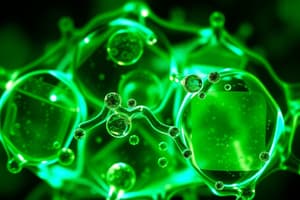Podcast
Questions and Answers
Which of the following is a potential long-term consequence of enzyme inactivation by toxins?
Which of the following is a potential long-term consequence of enzyme inactivation by toxins?
- Immediate excretion of the toxin without causing any further damage.
- Temporary suppression of enzyme activity with no lasting effects.
- Persistent DNA mutations leading to cancer if repair mechanisms fail. (correct)
- Increased production of protective enzymes to counteract the toxin's effects.
What role does glutathione (GSH) play in phase two reactions, and why is it important?
What role does glutathione (GSH) play in phase two reactions, and why is it important?
- It converts lipophilic chemicals into primary metabolites through hydrolysis.
- It neutralizes reactive metabolites, preventing cellular damage from toxic compounds. (correct)
- It enhances the activity of cytochrome P450 enzymes, increasing detoxification rates.
- It slows down the metabolism of drugs, leading to increased therapeutic effects.
How might exposure to environmental chemicals like benzene from cigarette smoke lead to carcinogenic effects?
How might exposure to environmental chemicals like benzene from cigarette smoke lead to carcinogenic effects?
- Benzene directly damages cellular membranes, causing immediate cell death.
- Benzene enhances glutathione production, protecting cells from oxidative stress.
- Benzene is metabolized into DNA-binding metabolites that increase the risk of cancer. (correct)
- Benzene inhibits cytochrome P450 enzymes, preventing the detoxification of other harmful compounds.
Which of the following best describes how carbon tetrachloride ($CCl_4$) causes liver damage?
Which of the following best describes how carbon tetrachloride ($CCl_4$) causes liver damage?
How does the metabolism of ethanol via the CYP2E1 pathway contribute to oxidative stress, and what are the potential consequences of this oxidative stress at the cellular level?
How does the metabolism of ethanol via the CYP2E1 pathway contribute to oxidative stress, and what are the potential consequences of this oxidative stress at the cellular level?
What are the implications of increased intestinal permeability due to chronic alcohol consumption on systemic inflammation and overall health?
What are the implications of increased intestinal permeability due to chronic alcohol consumption on systemic inflammation and overall health?
In chronic alcoholism, which pathophysiological process directly contributes to the development of esophageal varices?
In chronic alcoholism, which pathophysiological process directly contributes to the development of esophageal varices?
What is the MOST likely underlying mechanism for cocaine-induced hyperthermia?
What is the MOST likely underlying mechanism for cocaine-induced hyperthermia?
In chronic marijuana smokers, respiratory symptoms such as laryngitis, bronchitis, and cough are commonly observed. What is the primary mechanism by which marijuana smoke induces these conditions?
In chronic marijuana smokers, respiratory symptoms such as laryngitis, bronchitis, and cough are commonly observed. What is the primary mechanism by which marijuana smoke induces these conditions?
Beyond direct effects on neurotransmitter systems, how can chronic cocaine use lead to dilated cardiomyopathy?
Beyond direct effects on neurotransmitter systems, how can chronic cocaine use lead to dilated cardiomyopathy?
A patient presents with microcytic, hypochromic anemia and basophilic stippling on a peripheral blood smear. Which of the following underlying mechanisms most likely explains these findings?
A patient presents with microcytic, hypochromic anemia and basophilic stippling on a peripheral blood smear. Which of the following underlying mechanisms most likely explains these findings?
Why are children more vulnerable to the neurotoxic effects of lead compared to adults?
Why are children more vulnerable to the neurotoxic effects of lead compared to adults?
Which of the following is the MOST likely early indicator of lead exposure in a child, warranting further investigation?
Which of the following is the MOST likely early indicator of lead exposure in a child, warranting further investigation?
Which factor primarily determines if menopausal hormone therapy (MHT) might exert a protective effect against atherosclerosis and coronary artery disease (CAD)?
Which factor primarily determines if menopausal hormone therapy (MHT) might exert a protective effect against atherosclerosis and coronary artery disease (CAD)?
How does the understanding of 'idiosyncrasy' differ from 'dose-dependent adverse effects' in the context of therapeutic drug reactions?
How does the understanding of 'idiosyncrasy' differ from 'dose-dependent adverse effects' in the context of therapeutic drug reactions?
Flashcards
Entry of Environmental Chemicals
Entry of Environmental Chemicals
Chemicals enter the body through inhalation, ingestion, or skin contact, affecting cells directly or after transport via the bloodstream.
Lipophilic Compounds
Lipophilic Compounds
Fat-soluble compounds dissolve in fats, facilitating blood transport and cell penetration, impacting drug dosage and toxicity.
Detoxification of Chemicals
Detoxification of Chemicals
Chemicals are converted into water-soluble forms for excretion via urine, bile, or feces, mainly occurring in the liver.
Activation of Non-Toxic Compounds
Activation of Non-Toxic Compounds
Signup and view all the flashcards
Phase 1 Reactions
Phase 1 Reactions
Signup and view all the flashcards
Phase 2 Reactions
Phase 2 Reactions
Signup and view all the flashcards
Cytochrome P450 (CYP)
Cytochrome P450 (CYP)
Signup and view all the flashcards
Carbon Tetrachloride (CCl₄)
Carbon Tetrachloride (CCl₄)
Signup and view all the flashcards
Benzene (cigarette smoke)
Benzene (cigarette smoke)
Signup and view all the flashcards
Genetic Variability in CYP
Genetic Variability in CYP
Signup and view all the flashcards
CYP Inducers
CYP Inducers
Signup and view all the flashcards
Tobacco
Tobacco
Signup and view all the flashcards
Nicotine
Nicotine
Signup and view all the flashcards
COPD
COPD
Signup and view all the flashcards
Alcohol use
Alcohol use
Signup and view all the flashcards
Study Notes
Chemical Injury & Genetic Influence on Metabolism
- Environmental chemicals enter the body via inhalation, ingestion, or skin absorption
- Chemicals may act at the site of entry or be transported through the bloodstream
- Fat-soluble toxins can accumulate in adipose tissue, leading to prolonged toxicity
Lipophilic Compounds
- Lipophilic compounds dissolve in fat
- Facilitates transport in the blood via lipid-binding proteins
- Allows penetration through plasma membranes into cells
- Lipophilic drugs have extended half-lives and require careful dosage adjustments
Detoxification & Metabolism
- Most external compounds are metabolized into water-soluble forms for excretion through urine, bile, or feces
- Detoxification occurs primarily in the liver
- Impaired liver function increases the risk of drug toxicity
- Some chemicals are converted into reactive metabolites that damage DNA, proteins, and cellular membranes
- Enzyme inactivation by toxins can have short-term or long-term effects
Phases of Chemical Metabolism
Phase 1 Reactions
- Chemicals undergo hydrolysis, oxidation, or reduction
- Converts lipophilic chemicals into primary metabolites
- Phase 1 reactions can create reactive intermediate molecules
Phase 2 Reactions
- Phase 1 metabolites are modified into water-soluble compounds for safe elimination
- Involves glucuronidation, sulfation, methylation, and conjugation with glutathione (GSH)
- Impaired Phase 2 metabolism can lead to toxic accumulation
Cytochrome P450 Enzyme System (CYP)
- Key catalyst in Phase 1 detoxification reactions
- Processes drugs, toxins, and endogenous compounds
- Cytochrome P450 enzymes (CYP)
- Heme-containing proteins specialized for oxidative metabolism
- Primarily located in the endoplasmic reticulum of hepatocytes
- Also present in skin, lungs, and gastrointestinal tract
- CYP system detoxifies environmental chemicals and pollutants
- Can activate pro-drugs into therapeutic compounds or reactive metabolites
- Produces reactive oxygen species (ROS), contributing to oxidative stress
Examples of Chemical Metabolism Via Cytochrome P450
Carbon Tetrachloride (CCl₄)
- Used in dry cleaning and fire extinguishers
- Activated into a toxic free radical (trichloromethyl radical) that causes severe liver damage
Benzene (Cigarette Smoke)
- Metabolized in the lungs, producing DNA-binding carcinogenic metabolites
- Increases the risk of lung cancer
Alcohol & Common Drugs
- Cytochrome P450 metabolizes alcohol, influencing the risk of alcoholic liver disease
- Other drugs metabolized by CYP system include Acetaminophen, Barbiturates, Warfarin, Anticonvulsants
Genetic Variability in Cytochrome P450 Activity
- CYP enzyme function varies significantly between individuals, influencing drug metabolism and toxicity
- Factors influencing CYP activity include Genetic polymorphisms and Drug exposure
Inducers & Inhibitors of Cytochrome P450
CYP Inducers
- Enhance CYP function, leading to faster drug metabolism and clearance
- Examples include Phenobarbital, Rifampin, and Smoking
- Inducers decrease drug efficacy
CYP Inhibitors
- Suppress CYP function, slowing drug metabolism and clearance
- Examples include Omeprazole, Ketoconazole, and Grapefruit juice
- Inhibitors increase drug toxicity
Clinical Considerations
- Genetic variability, diet, and drug interactions affect drug metabolism
- Personalized medicine aims to adjust dosing based on CYP activity
- Patients with altered CYP function require dose adjustments
Pathogenesis of Tobacco Use & Resultant Pathologic Changes in Affected Organs
- Tobacco contains carcinogens and toxins that cause cancers and cardiovascular disease
- Cigarette smoking and smokeless tobacco can both be culprits
Impact of Tobacco Use on Health
- Tobacco smoke contains polycyclic aromatic hydrocarbons (PAHs), nitrosamines, and carbon monoxide
- Main culprit is cigarette smoking, but smokeless tobacco also causes oral cancer
Organs Most Frequently Affected
- Oral cavity, larynx, esophagus, lung, stomach, pancreas, cardiovascular system, and bladder
- Chemicals in tobacco are metabolized in the liver, creating reactive metabolites
Secondhand Smoke Exposure
- Secondhand smoke exposure causes coronary atherosclerosis and myocardial infarction
- Between 30,000 - 60,000 deaths per year in the U.S due to secondhand smoke
Addictive Nature of Tobacco
- Nicotine binds to nicotinic receptors in the brain and peripheral tissues
- Nicotine stimulates dopamine release and increases blood pressure and heart rate
- Withdrawal from nicotine can lead to irritability, anxiety, and increased appetite
Major Diseases Caused by Cigarette Smoking
Pulmonary Diseases
- Affects the lungs, leading to emphysema, chronic bronchitis, and lung cancer
- Smoking can also cause heart attacks
- In pregnant women, it can cause spontaneous abortion, preterm birth, and intrauterine growth restriction (IUGR)
Chronic Obstructive Pulmonary Disease (COPD)
- COPD consists of bronchitis and emphysema
- Smoking activates neutrophils and macrophages, increasing elastase production
Chronic Bronchitis
- Defined as persistent productive cough for at least three consecutive months in at least two consecutive years
Microscopic Features of Emphysema
- Loss of distal air spaces
- Remaining air spaces become dilated
- Loss of lung elasticity and Increased total lung capacity
- Reduced diaphragmatic expansion
Carcinogens in Cigarette Smoke
- Polycyclic hydrocarbons & nitrosamines are carcinogens in tobacco smoke
- Cancer risk increases with cumulative exposure
- Pack-years are used to quantify smoking exposure
Example: Squamous Cell Carcinoma from a Smoker
- Squamous cell carcinoma is a common primary lung malignancy in smokers
- Arises centrally in the lung and is firm with pale white cut surfaces
- Anthracotic Pigment is accumulated carbon deposits
Pathogenesis of Alcohol Use & Resultant Pathologic Changes in Affected Organs
- Excessive acute or chronic ethanol consumption leads to marked physical and psychological damage
- The US estimates ~10 million chronic alcoholics
- Alcohol causes over 100,000 deaths annually
Alcohol Absorption & Metabolism
- Ethanol is absorbed in the stomach and small intestine and distributed through the body
- Less than 10% of ingested alcohol is excreted unchanged in urine, sweat, and breath
- Ethanol is oxidized to acetaldehyde through three major enzymatic pathways, Cytochrome P450 (CYP2E1) system, Alcohol dehydrogenase (ADH), and Catalase
- Acetaldehyde is further converted into acetate by acetaldehyde dehydrogenase (ALDH) in the mitochondria
Role of Cytochrome P450 (CYP2E1) in Alcohol Metabolism
- This system is highly induced in chronic alcoholics, increasing ethanol metabolism
- This metabolic process elevates the production of reactive oxygen species (ROS) & causing oxidative stress
Pathologic Effects of Alcohol on Organs
Direct Toxic Effects (Point of Entry)
- Stomach and small intestine are highly vulnerable to ethanol-induced injury
- Can cause increased intestinal permeability
Indirect Toxic Effects (Metabolism in Liver)
- The liver is the primary site of alcohol metabolism
- Alcohol oxidation by ADH in hepatocytes disrupts cellular redox balance
- Deficiency in NAD+ leads to lipid accumulation in the hepatocytes, resulting in fatty liver (hepatic steatosis)
Fatty Liver (Hepatic Steatosis) Development
- High NADH levels favor lipid accumulation, leading to excess fat deposition in hepatocytes
- Fatty liver appears as a pale, enlarged liver filled with lipid droplets
- Can progress to more severe liver diseases, including alcoholic hepatitis and cirrhosis
- Fatty liver is reversible with alcohol cessation
Acute vs. Chronic Toxicity
Acute Toxicity of Alcohol
- Depresses neural activity in the central nervous system (CNS), impairing motor, sensory, and cognitive function
- Can cause stupor, coma, or death
- Can cause Acute gastritis and ulceration of the stomach
Chronic Toxicity of Alcohol
- Liver is the primary site of chronic injury, may take form of alcohol hepatitis and cirrhosis
- Cirrhosis may lead to portal hypertension
How Alcoholism Leads to Esophageal Varices
- Chronic alcohol leads to Liver Cirrhosis
- Cirrhosis leads to obstructrial blood flow causing Portal Hypertension
- The backed up blood has high pressure, causing Formation of Varices
- Dilation makes them thin and dangerous, leading to possible massive upper GI bleeding
Neurologic Effects of Chronic Alcoholism
- Thymine deficiency is common, leading to Peripheral neuropathy and Wernicke-Korsakoff syndrome
- Can also cause cerebral atrophy, degeneration of the cerebellum, and optic neuropathy
Cardiovascular Effects of Alcohol
- Can damage the myocardium, producing dilated congestive cardiomyopathy
- Can induce fetal alchohol syndrome in developing fetus.
Cocaine and Marijuana: Mechanisms, Effects, and Toxicities
- Cocaine is extracted from the leaves of the coca plant
- Marijuana is made from the leaves of cannabis
Prevalence of Cocaine Use
- An estimated 5.5 million people in the United States used cocaine (2018)
- Cocaine is sold as powder or as crack, which are crystals of cocaine hydrochloride
- Usages include snorting, smoking or injecting
Mechanism of Action
- Cocaine is a sympathomimetic agent, acting on both the central nervous system (CNS) and adrenergic nerve endings
- Blocks dopamine reuptake, leading to dopamine accumulation in the synaptic cleft
- Results in hyperstimulation, causing Euphoria, Paranoia, and Hyperthermia
- Cocaine blocks reuptake of epinephrine and norepinephrine, enhancing sympathetic activity
Acute Toxicity
- Dangerous acute effect of cocaine is on the cardiovascular system, causing Hypertension, tachycardia, peripheral vasoconstriction, and coronary artery vasoconstriction
- May result in Myocardial ischemia or infarction
- Can also experience Seizures, Hyperthermia, and Fetal hypoxia
Chronic Toxicity
- Can cause Nasal septum perforation and Decreased lung diffusing capacity
- Dilated cardiomyopathy is also a result of cocaine use
Cocaine Withdrawal
- Symptoms of withdrawal include Psychological effects, Physiologic crash, depression, and Fatigue
- Treatment includes supportive care and Psychotherapy
Marijuana
- Most widely used illegal drug in the United States, with approximately 44 million users in 2017
- Consists of Delta-9-tetrahydrocannabinol
- Distorts sensory perception, including Time, speed, and distance perception
Prevalence of Marijuana Use
- Approximately 44 million people used marijuana in 2017 in the United States
- Made from the leaves of Cannabis sativa, Cannabis indica, or hybrids of the two species
- This psychoactive substance is Delta nine tetrahydrocannabinol, abbreviated SDHC
Acute Effects
- Distorts sensory perception, including Time, speed, and distance perception and Impaired motor coordination, lasting 4-5 hours
- Cardiovascular effects include Increased heart rate and sometimes blood pressure
Chronic Effects
Respiratory effects can include Laryngitis, bronchitis, and cough
Pathogenesis of Lead Exposure & Resultant Pathologic Changes in Affected Organs
- Lead primarily enters the body via ingestion or inhalation
- Inhalation is a less concern after the ban in in 1996
- Poisoning can come from contaminated foods, water, old house paint, and occupational exposure
Mechanisms of Lead Toxicity & Organ Damage
- Lead binds to sulfhydryl groups in proteins and interferes with cancer metabolism
- This leads to Hematologic, skeletal, neurologic, gastrointestinal and renal toxicity
Why are Children More Vulnerable to Lead Toxicity?
- Children have higher absorption rates and a more permeable blood-brain barrier
Pathologic Changes in Affected Organs
Hematologic System
- Lead interferes with activity of several enzymes that are required for heme synthesis, leading to anemia
- Microcytic, hypochromic anemia associated with punctate and basophilic stipling of red cells
Skeletal System
- Lead accumulation in bones and teeth, altering calcium metabolism
- Lead deposited in epiphysis, gives bright white lines called lead lines
Nervous System
- In children, can lead to brain edema, de minimisation of white matter and neuron destruction
- In adults, it can lead to peripheral demyelinating neuropathy
Renal System
- Lead can lead to proximal tubular damage and chronic to interstitial fibrosis
Diagnosis of Lead Toxicity
Definitive diagnosis is through a blood test
Treatment of Lead Toxicity
Treatment aims to eliminate exposure with Chelation therapy
Toxic Effects of Therapeutic Drugs: Idiosyncratic vs. Dose-Dependent Reactions
Adverse drug reactions are untoward effects of drugs These reactions are extremely common, affecting seven to 8% of patients Estrogen and oral contraceptives are discussed in detail
Menopausal Hormone Therapy (MHT)
- MHT consists of the administration of estrogens together with the progestogen
- This is used primarily to counteract hot flashes and other symptoms of menopause
- MHT may have a protective effect on the development of atherosclerosis and coronary artery disease
- MHD increases the risk of stroke and thromboembolism
Oral Contraceptives
- Usually contain a synthetic stradial and a variable amount of protesting
- Oral contraceptives are associated with small increased risk of breast cancer
- Can have a protective effect against endometrial and ovarian cancers
- Increased risk of cervical carcinomas in women infected with human papillomavirus
- Increasedhepatic synthesis of coagulation factors resulting from increased hepatic synthesis of coagulation factors
- associated with a rare benign hepatic tumor called hepatic adenoma, especially in older women who have used oral contraceptives for prolonged periods of time
Idiosyncratic vs Dose Dependent
- Idiosyncrasy is defined as an abnormal reactivity to a chemical that is particular to a given individual.
- Attributes of being not dose dependent, unpredictable and specific to an individual
- Either the drug itself or a reactive metabolite will bind to a protein
- Can cause Virtually every idiosyncratic response Symptoms usually appear after a long delay between starting the drug and the onset of symptoms
Dose Dependent adversity
These symptoms are directly proportional with the dose predictable, affecting to all who take the drug
Studying That Suits You
Use AI to generate personalized quizzes and flashcards to suit your learning preferences.




